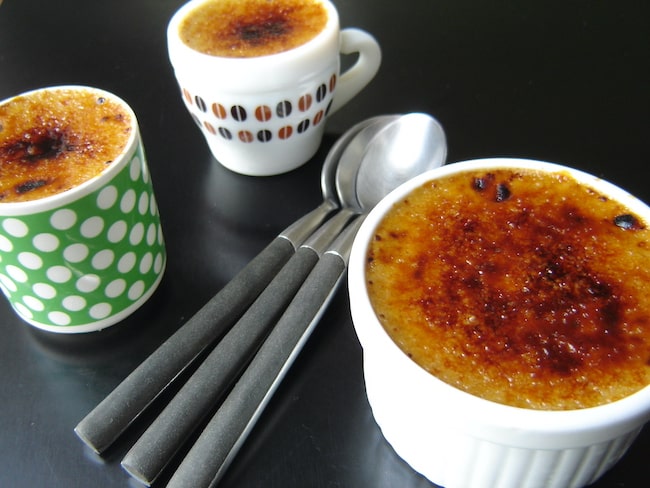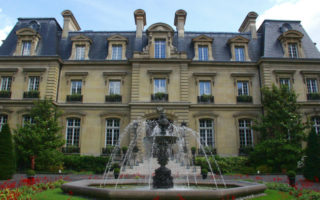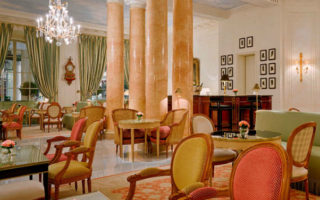Coffee Drinking in Paris
Have you ever had a really great cup of coffee in Paris? Until the city experienced the “third wave” of coffee drinking about a decade ago, most of us contented ourselves with the ordinary caoua found in Parisian cafés. It was often bitter, made from burned (not roasted) coffee beans, and the average cup was a purely utilitarian beverage, designed to satisfy a caffeine craving, but not our tastebuds.
For years, I just accepted this sorry state of affairs, since the coffee ritual seemed to be more about the environment than the actual brew in my cup. One of two experiences awaited me, depending on the amount of time I had.
When I was pressed for time, I’d go into a café, stand at the bar, and order a coffee with as little water as possible: a café serré or “tight” coffee. I’d demonstrate what I wanted to the busy server by turning my fist in the air, like I was gripping and tightening a wrench. Then I’d drink the stuff summarily while leafing through Le Parisien newspaper on the counter or listening to the local gossip and bar banter before heading out the door to greet the day’s tasks.
Other times, I’d sit at a table and order a café allongé, one with more liquid and served in a bigger cup. I’d spend the next half-hour or so lingering over the coffee and ruminating my morning thoughts in a public place. (Which really meant just staring into space while waiting for the caffeine to kick in.)

A courageous café and restaurant owner sells carry-out dishes and, of course, coffee. Photo © Allison Zinder
Other sleepy customers would push open the glass door of one of my favorite cafés, and let in the green-smelling gust coming off the beautiful Square Gardette in the 11th district. And there I’d sit, wondering how long I could make one cup of coffee last while I reflected on the meaning of the dream that woke me so suddenly that morning.
But even with the great coffee available to us in Paris now, the coffee-drinking experience has been upended in these pandemic times. Since cafés and restaurants are “closed” (which in Paris means that many are still open, at least for carry-out), customers drink coffee in paper cups either lingering in front of the café, or perched on a park bench – or even the curb! – somewhere nearby. Still others walk and sip, eschewing the traditional pause-and-reflect part of the coffee ritual.

Other offerings at this café, besides coffee to go, are mulled wine, onion soup, and “Anti-covid” juice made from apples, carrots, lemon juice, and ginger. Who knew? Photo © Allison Zinder
So nowadays, I’m sipping coffee at home most of the time. But sometimes I like to use coffee in recipes, like the one below: Extra-Rich Coffee Crème Brûlée. What makes a perfect crème brûlée? It’s the contrast in textures and temperatures between the very cold, smooth custard lying underneath the warm and crispy burnt sugar, which crème brûlée connoisseurs delight in cracking oh-so-gently with their spoons before delicately delving in to the custard.

Extra-Rich Coffee Crème Brûlée, served in ramekins, or multi-sized and mismatched coffee cups. Photo © Allison Zinder
This recipe is not a standard crème brûlée, but an ultra-rich fine-dining restaurant recipe that we perfected and used when I worked with the one-Michelin-starred chef Gérard Bossé in the Loire Valley. A high proportion of egg yolks to other ingredients means a richer custard – perfect for a luxurious finish to a gourmet meal. But even if the meal you served isn’t of gourmet calibre, no worries – this way of ending the repast will leave you happy and fulfilled.
I prefer to make crème brûlée in small ramekins, or even multi-sized and mismatched coffee cups, not the wide shallow dishes found in many restaurants in France. When you torch the sugar, it tends to heat up the too-thin layer of custard underneath. But then again, there’s always bound to be much discussion about the importance of custard-to-caramelized-sugar ratio, which some people seem to better appreciate in the shallow dishes. Do as you like, but you’ll have to adjust the cooking time (less for shallow dishes).
The success of this recipe also depends on two other factors: first, maturing the mix, which simply means putting the raw ingredients together the day before you want to serve the custards. Second, after cooking and cooling, the custards should be refrigerated overnight so they set correctly. Bon app’!

Extra-Rich Coffee Crème Brûlée, served in ramekins, or multi-sized and mismatched coffee cups. Photo © Allison Zinder
Extra-Rich Coffee Crème Brûlée
Ingredients:
- 1 cup (240 ml) milk
- 1¼ cups (300 ml) heavy cream
- 3 teaspoons (4 g) coarsely-ground coffee (the very same coffee you’d put in a French press), or ground coffee for a drip brew machine (you’ll need a very fine strainer)
- 6 egg yolks
- ⅓ cup (65 g) turbinado (raw) sugar
- 3-4 teaspoons turbinado (raw) sugar (for the top of your custards)
how to make it:
- Two days before you want to eat the custards, make the mix. Begin by heating the milk and cream together in a small saucepan over medium heat.
- When the liquids have reached a boil, turn off the heat, and add the ground coffee. Whisk well and cover the pan. Let the coffee infuse the milk and cream for about 10 minutes, then pour through a very fine-meshed strainer. Let the milk and cream cool completely.
- In a medium bowl, whisk together vigorously the egg yolks and the ⅓ cup sugar for about three minutes, making sure to push stray sugar grains down from the sides of the bowl. Add in the strained coffee-infused milk and cream, and whisk thoroughly. Cover tightly and leave to mature in the fridge overnight.
- The next day, preheat the oven to 300° F (150° C).
- Making sure to have hot water at the ready, fill your ramekins or cups to the top rim with the mix, and place them in a baking pan with at least 2-inch sides, staggering them so the water will be able to circulate freely around them and heat the cups evenly. To avoid spillage, I usually set the pan with the ramekins in the oven before pouring in the water to about three-fourths of the way up the sides.
- Cook in the oven for anywhere from 30 minutes to 1 hour, depending on your ramekin depth, or until the custards still jiggle just a little in the center. Remove from the oven, let cool, and refrigerate overnight.
- The next day, just before serving, sprinkle the custards with the sugar, and torch the tops using a small kitchen blowtorch, working in a slow, back-and-forth motion to caramelize the sugar.
- Serve immediately, and enjoy the smooth richness… Régalez-vous!
Makes 4-5 custards in standard 1-serving ramekins.

Allison Zinder with her cup of coffee Photo © Allison Zinder
Want to be inspired by more French foodie experiences and enjoy classic French food, wine and recipes? Head to our sister website, Taste of France, here.
Lead photo credit : Ahh, a Parisian-style and pre-pandemic cup of coffee. Photo © Allison Zinder
More in coffee, coffee in Paris, Dessert, gastronomy, recipe, restaurant






REPLY